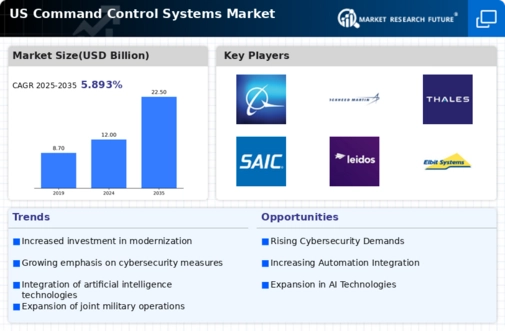The competitive landscape of the US Command Control Systems Market is characterized by a dynamic interplay between technology advancements, defense needs, and strategic partnerships. This sector is pivotal for national security and military operations, amid evolving threats and the increasing importance of integrated systems for defense agencies. Participants in this market are constantly innovating to enhance communication, control, and situational awareness, which are essential for effective command and control operations. As geopolitical tensions and defense budgets fluctuate, market players are exploring new capabilities and diversifying their product offerings to meet the demands of military and government stakeholders.
Raytheon Technologies has established a significant presence in the US Command Control Systems Market, benefiting from its robust portfolio of advanced technologies and services tailored for defense applications. The company’s strengths lie in its deep expertise in integrated systems, which allows for seamless communication and coordination between various military branches. Raytheon Technologies has invested heavily in research and development, positioning itself as a leader in innovative solutions that enhance operational efficiency. The company has also formed strategic partnerships with government agencies to ensure that its products meet the ever-evolving requirements of modern warfare.
This commitment to excellence and innovation underlines Raytheon Technologies' competitive edge in the market, affording it a strong foothold amidst growing demands for state-of-the-art command control systems.Boeing plays a vital role in the US Command Control Systems Market, leveraging its extensive aerospace and defense experience to deliver tailored solutions for military and government customers. The company offers a range of key products and services that include command and control centers, advanced communication systems, and integrated solutions facilitating joint operations among the armed forces.
Boeing's strength lies in its ability to combine cutting-edge technology with deep industry knowledge, fostering innovations that enhance situational awareness and decision-making capabilities. In recent years, Boeing has pursued strategic mergers and acquisitions to expand its capabilities, fostering collaborations that strengthen its market position. With a focus on delivering comprehensive support and ongoing advancements in its systems, Boeing remains a formidable competitor in the US Command Control Systems Market, demonstrating a commitment to enhance defense and operational effectiveness on both domestic and international fronts.


















